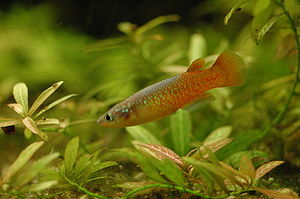- Pachypanchax omalonotus
-
Madagaskar-Hechtling Systematik Überordnung: Stachelflosser (Acanthopterygii) Ordnung: Zahnkärpflinge (Cyprinodontiformes) Familie: Aplocheilidae Gattung: Pachypanchax Art: Madagaskar-Hechtling Wissenschaftlicher Name Pachypanchax omalonotus (Duméril, 1861) Der Madagaskar-Hechtling (Pachypanchax omalonotus) ist eine auf Madagaskar vorkommende Fischart. Als Zierfisch hat er für die Aquaristik Bedeutung, wird aber relativ selten gehalten.
In älterer Literatur wird er häufig unter dem Synonym P. homalonotus geführt.
Inhaltsverzeichnis
Verbreitung und Lebensraum
Das Verbreitungsgebiet des Madagaskar-Hechtling beschränkt sich auf die Insel Nosy Be, das Flussgebiet des Sambirano im unmittelbar angrenzenden Festland und einige kleinere Küstenflüsse auf der Halbinsel Ankify.
Auf Nosy Be lebt er im Süßwasser der Ober- und Mittelläufe kleinerer Flüsse und Bäche. Auf dem Festland bewohnt er sowohl schattige Fließgewässer wie auch flache, sumpfige Seen im Überflutungsgebiet des Sambirano.
Merkmale
Die äußere Erscheinung entspricht der typischen Gestalt von Vertretern der Gattung Pachypanchax, lediglich die Schwanzflosse ist eher spatenförmig und die Rücken- und Afterflosse laufen in einer Spitze aus. Die Seiten sind von smaragdener Farbe, wobei die Schuppen rötlich gerandet sind. After- und Schwanzflosse sind unten hellgelb oder weiß gesäumt. Es existiert außerdem eine Variation mit überwiegend roter Färbung.
- Dorsale II-III/9-11
- Anale II-III/14-17
- Pectorale 12-16
- Ventrale I/5
Lebensweise
Der innerartlich recht unverträgliche Madagaskar-Hechtling ernährt sich hauptsächlich von Wirbellosen. Diese werden entweder als Anflugnahrung an der Wasseroberfläche abgesammelt oder auf dem Gewässergrund gefangen. Aus dem oberflächennah in feingliedrigen Pflanzen abgelegten Laich schlüpfen die Larven nach etwa 2 Wochen. Bei Beobachtungen in Gefangenschaft legten die Weibchen täglich ungefähr 20 der im Durchmesser 1,5 Millimeter großen Eier.
Quellen
Literatur
- Claus Schaefer, Dr. Torsten Schröer: Das große Lexikon der Aquaristik, Ulmer Verlag, Stuttgart 2004, ISBN 3-8001-7497-9
- Frank Glaw, Miguel Vences: A Fieldguide to the Amphibians and Reptiles of Madagascar, 2nd Edition, M. Vences & F. Glaws Verlags GbR, 1994, ISBN 3-929449-01-3
Weblinks
- A review of the Malagasy Pachypanchax (Teleostei: Cyprinodontiformes, Aplocheilidae), with descriptions of four new species (engl., pdf)
- Pachypanchax omalonotus bei fishbase
- Pachypanchax omalonotus in der Roten Liste gefährdeter Arten der IUCN 2006. Eingestellt von: Loiselle, P. & participants of the CBSG/ANGAP CAMP "Faune de Madagascar" workshop, Mantasoa, Madagascar 2001, 2004. Abgerufen am 05 März 2007
Wikimedia Foundation.

